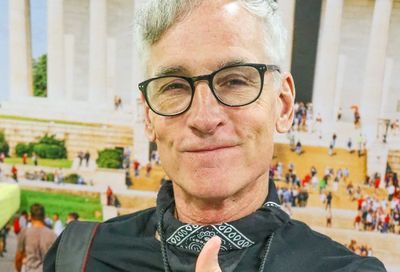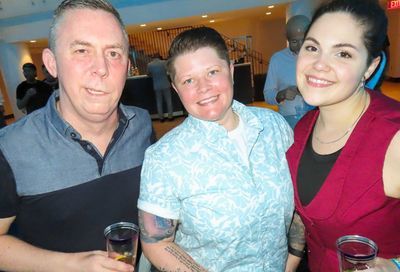Legendary: An Interview with Carol Channing (1995)
In 1995, Metro Weekly photographed Carol Channing for its cover. To honor the legend's passing, our interview appears online for the first time.

I will never forget the time I met Carol Channing. Metro Weekly was in its infancy and we had miraculously had scored not one, but two Broadway giants for our September 14, 1995 issue — Miss Channing and Tommy Tune. The impossibly tall Tune was at the Mechanic in Baltimore in Buskers!, while Channing was gracing the stage of the Kennedy Center Opera House, starring in the revival tour of Hello, Dolly!
Miss Channing’s reps agreed to an interview and, to my surprise, an actual photo shoot for the cover. At the time, we had a hard and fast rule: No publicity shots on the cover. Either we took the photo, or the interview was off. It was a risky game of chicken, but it paid off more often than not. (In the ensuing years, we relaxed that deal-breaker considerably.)
The shoot occurred in a backstage hallway at the Kennedy Center. Annie Adjchavanich, the magazine’s portrait photographer for our first two years, taped a small, black velvet backdrop to the wall, and we waited. Suddenly, the star materialized, sporting a midnight black turtleneck and gleaming white blazer offset by a red AIDS ribbon. A massive pair of sunglasses covered half her face. I politely asked Miss Channing if she’d remove the sunglasses. She politely declined, confiding that she had not had time to affix her eyelashes.
Annie had 5 minutes to get the shot. And boy, did she ever get it — an ebullient portrait filled with the kind of life and zest that typified the iconic star. For the magazine’s inside, I had pre-commissioned a piece of key art from our illustrator Paul Myatt, in case the shoot fell through. Art director Daryl Wakeley used one of Paul’s drawings to open the piece. (I will post a few of Paul’s original variations, along with the original, later on our Instagram, so give us a follow if you’re interested.)
The interview happened the following day. It was a Friday afternoon, and I had been granted a hard 20 minutes, no overage. It was to be conducted in person, in Miss Channing’s Watergate Hotel suite. I remember arriving to a roomful of Kennedy Center reps and Miss Channing’s entourage, possibly her husband, definitely her manager. Miss Channing was not yet present. And then, a door opened and in she strode, wearing a white terrycloth bathrobe, touselled blonde wig, and those giant sunglasses. She was barefoot, her toes painted a bright ruby red.
Within moments, her charm, her poise, her irrepressible energy had me in her thrall. I have met a lot of celebrities in my 40 years as an entertainment journalist, and it’s very rare I get starstruck. But on that day, I was not only massively starstruck, but struck by how sweet, down-to-earth, forthcoming, and vibrant this iconic star of the stage and screen was in person. She was a delight to speak with, if only for 20 minutes. And it was at that moment I realized I was in the presence of one of our greatest, most unique national treasures. May she rest in peace. —Randy Shulman, Editor-in-Chief
What follows is Metro Weekly’s original cover story interview, “Legendary,” never before published online, from the issue dated Sept. 14, 1995.
—
When The Legend walks into a room, all time stops. Not to mention one’s heart. Here, before one’s eyes, is the original Lorelei from Gentlemen Prefer Blondes. Here, before one’s eyes, is the original Dolly Levi. Here, before one’s eyes is the single greatest living female Broadway star.
Currently The Legend, a spirited, dynamic 74, is back where she belongs touring in the Broadway-bound revival of Hello, Dolly! Forget that other legend, the one who appeared in the movie — this legend plays the role the way it was meant to be played.
And on this Friday afternoon — the most splendid, sunny Friday afternoon that there ever was — you have been granted a few minutes of The Legend’s time. Call it: “Fifteen minutes with fame.” As The Legend speaks — the voice deep, resonant, familiar — it occurs to you that this woman is akin to a priceless, flawless diamond: She glitters and sparkles — and the rest of the world gazes on with nothing less than adoration.
METRO WEEKLY: The first question I absolutely must ask — I know you’ve been asked this before — but after having done over 4,000 performances of Hello, Dolly!, what do you do to keep it fresh?
CAROL CHANNING: That is a natural question to ask, isn’t it? Every interview begins with it. I don’t have to do anything to keep it fresh. You don’t have to do anything to rev yourself up if you’re doing the very thing you love. And I learn something new every show. Every show.
MW: But even so, eight performances a week is a grind, it’s a lot of work. Have you been on stage and felt that “I’m not doing my best and need to punch things up?”
CHANNING: Always, always. To hold an audience is an unnatural thing. It’s only natural to lose them; it’s only natural for the magic spell to break, and for them to stop believing it’s really happening right there in front of them for the first time. All it takes [on my part] is concentration. Don’t let it waver. Don’t ever, ever let it waver.
MW: Did you come from a musical family?

CHANNING: No. My father was a newspaper man, and then he was a Christian Science lecturer. He went all over the world. So now there’s hardly a huge auditorium that we play [in which] he wasn’t there ahead of me, which gives me great confidence.
MW: So we could say you’re following in your father’s footsteps.
CHANNING: Yes… maybe… I never thought of that, [but] it does give me confidence. You know, I talked to Julie Andrews about this between scenes on Thoroughly Modern Millie, and she said, “Do you think that we are little Florence Nightingales trying to help people, trying to uplift their lives?” That’s exactly the way we feel. That’s why we don’t get tired of it.
MW: There’s a wonderfully funny scene in act two of Dolly where you eat one potato puff after potato puff — I think it’s close to twenty in all. How on earth do you do this?
CHANNING: Well, we used to use [spun] sugar. I ate them for a year [in the original 1964 production] and got some kind of sugar condition — I can’t ever touch sugar now. So then Gower [Champion, the show’s original director] said, “I’ll get in touch with Charlie Chaplin’s man who made that show that he ate.” He also made 500 link sausages and the camera never stopped. And he came and taught the crew how to make the potato puffs out of rice paper. They turn into spitballs. I swallow 22 of them, depending on how much the audience laughs. If they laugh more, I swallow a couple more. It’s not easy, though. I have an understudy, and she can only get three of them in. So I guess I just have a big mouth.
MW: You’re one of the few Broadway legends left who go out on the road. Most stars don’t do that anymore. They just sit on Broadway and wait for the audiences to come to them.
CHANNING: If your name is above the title, it’s your obligation [to take it on the road]…. Also, we’re in a position to help with AIDS and [other] benefits. We are in that position. Nobody else can help, except public figures. And we’re public figures. So it’s part of what we owe. It’s part of giving back.
MW: Your current Dolly company’s AIDS fundraising efforts have been impressive.
CHANNING: Our company is amazing. They made up their minds that in every city we’d play, we would do an AIDS benefit after the show. It’s a separate show — it has nothing to do with Hello, Dolly! So far we’ve raised $200,000 for Broadway Cares/Equity Fights AIDS.
MW: There are so many female impersonators who include a version of you in their act. How do you feel about that?
CHANNING: They have to like me or they wouldn’t do me. I never wanted to be any character that I didn’t love. I know what it comes out of: they finally decide, “I’ll be Carol.” And it’s usually awfully funny, very astutely funny.
MW: You were one of the people to have made Richard Nixon’s Hate LIst — a group of people he would not allow into the White House — which you include as one of your greatest honors. Tell us about that.
CHANNING: What happened was I gave Mrs. Nixon a diamond [as part of my] “Diamonds Are a Girl’s Best Friend [Award]” when we were playing the National Theatre [in the early ’70s]. It was right when Watergate broke wide open. And Mrs. Nixon walked out with her head raised high, much prettier than she ever looked in the pictures — she was lovely…

And she sat down, and I started to entertain her with the Diamond Award Speech. [I gave it to her] “for making friends all the way from Africa to China.” As I handed it to her, I said, “You may be wondering, ‘Is this diamond real?’ Well I should explain to you that the quality that gives a diamond its value is the amount of sentiment attached to it. And this diamond has much respect and affection, so it’s absolutely priceless. And today you are our diamond and we are all your best friends.
Well, she loved it. “Oh, I love this diamond,” she said, “I don’t have to give it to the Smithsonian Institute. I don’t have to hang it on the White House walls. This diamond I can wear.” She was so happy. Two days later, the hate list came out and went all over the world. All I could think was that Nixon had the ring appraised! [Laughs.]
MW: In the next month or so, Broadway is going to be filled with legends — you, Tommy Tune, Julie Andrews, Zoe Caldwell, Carol Burnett. It’s as though the Great White Way has come alive again.
CHANNING: It’s always been alive.
MW: But everyone is constantly moaning, “Broadway is dying, Broadway is dying.”
CHANNING: The first thing I learned at Bennington College as a drama/dance major was that the theater has been dying since mankind began. For some strange reason, it’s the human thing to say. When records came in with the Victrola, everybody said, “Oh, I guess that’s the death of live theater.” When radio came in, “Well, that’s the end of live theater.” When movies came in, “Well, I guess that’s the end of live theater.” But we’re not a lens. We’re not a record. There is nothing in the world like one human being contacting another. There’s nothing like it and it will never stop. But idiots that don’t think it through say, “Oh, the theater is dying! It must be! That’s what it must be doing automatically! Now we have televisions, so why should anybody go to the theater?” Well, because it’s live and it’s happening right there. I don’t understand why people don’t see that.
MW: One final question: Will you be writing your autobiography any time soon?
CHANNING: I haven’t really thought about it yet. You see, I’m only halfway up the mountain. I haven’t done half of what makes a person able to write a biography. Not really. If I were going to die tomorrow, I’d have to do it right away, like Gower Champion did. He called me and said, “Look, I’ve just found out that we all have dreams about what we want to do in the theater, and I’ve gotta do it now.” And I didn’t [realize] he was telling me “I’m going to die.” I didn’t know that. But I am not gonna die tomorrow. I still have plenty to do right here.
Support Metro Weekly’s Journalism
These are challenging times for news organizations. And yet it’s crucial we stay active and provide vital resources and information to both our local readers and the world. So won’t you please take a moment and consider supporting Metro Weekly with a membership? For as little as $5 a month, you can help ensure Metro Weekly magazine and MetroWeekly.com remain free, viable resources as we provide the best, most diverse, culturally-resonant LGBTQ coverage in both the D.C. region and around the world. Memberships come with exclusive perks and discounts, your own personal digital delivery of each week’s magazine (and an archive), access to our Member's Lounge when it launches this fall, and exclusive members-only items like Metro Weekly Membership Mugs and Tote Bags! Check out all our membership levels here and please join us today!




















You must be logged in to post a comment.